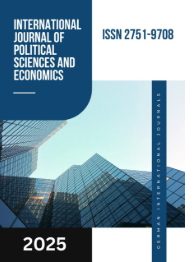LABOR MARKET AND UNEMPLOYMENT ISSUES:STATISTICALANALYSIS AND SOLUTION
DOI:
https://doi.org/10.55640/Keywords:
Labor market, unemployment, labor force, economic development, youth unemployment, rural employment, structural unemployment, cyclical unemployment, frictional unemployment, vocational training, job creation, human capital, employment policy, wage levels, productivity, informal employment, digital economy, labor mobility, skills mismatch, social protection, poverty, inequality, economic reforms.Abstract
This article provides the current state of the labor market and unemployment challenges through a comprehensive statistical analysis. The labor force plays a critical role in driving economic growth and stability. However, rising unemployment, particularly among youth and rural populations, has become a persistent issue in many countries, including developing economies. The study analyzes recent labor market data, highlighting trends in unemployment by age, gender, and region. Key causes such as structural changes, technological disruptions, and mismatches between education and job market needs are discussed in depth. Furthermore, the paper explores the socio-economic consequences of unemployment, including poverty, inequality, and reduced productivity. In response, various policy measures are evaluated, such as government employment programs, vocational training initiatives, and reforms aimed at improving labor market efficiency. The findings suggest that a coordinated approach involving public and private sectors is essential to address unemployment sustainably. By combining data-driven insights with practical policy recommendations, this study aims to contribute to informed decision-making and more resilient labor market development.
References
1.Abdullaev, M. Labor Market and Unemployment Issues in the Republic of Uzbekistan: An Analytical Study. Journal of Economics and Management, 3(12), 45-58. (2020).
2.Qodirov, B. Structure and Development Strategies of the Labor Market. Tashkent: National University of Uzbekistan Publishing. (2019).
3.Islomov, S.. Unemployment and Its Socio-Economic Consequences: The Case of Uzbekistan. Economic Research, 5(7), 22-37. (2021)
4.Davronov, T.Youth Unemployment and Labor Market Adaptation. Tashkent: Science and Technology Press. . (2018).
5.Ministry of Labor and Social Protection of the Population of the Republic of Uzbekistan Annual Report on the State of the Labor Market of the Republic of Uzbekistan. Tashkent: Official Publication. (2023).
6.Nematova, D. Adaptation of Vocational Education to Labor Market Needs. Journal of Education and Science, 4(15), 56-68. (2022).
7.Sultonov, A. Labor Legislation and Ways to Increase Labor Market Efficiency. Tashkent: Economics and Law Publishing. (2020).
8.Rustamov, J. Unemployment Reduction Policy in the Economy of Uzbekistan: Theoretical and Practical Aspects. National Economy Journal, 2(8), 12-29. (2019).
9.State Committee of the Republic of Uzbekistan on Statistics. Key Indicators of the Labor Market. Tashkent: Official Statistics. (2023)
10.Ergashev, M.Labor Force Market and Its Development Prospects. Tashkent: Center for Economic Research. (2021).
11.International Labour Organization (ILOWorld Employment and Social Outlook: Trends 2023. Geneva: ILO Publishing. ). (2023).
12.Blanchard, O., & Johnson, D. RMacroeconomics (6th ed.). Pearson Education. . (2013).
13.Freeman, R. B. Labor Economics (4th ed.). Routledge. (2010).
14.OECD.. OECD Employment Outlook 2022: Building Resilient Labor Markets. Paris: OECD Publishing. (2022)
15.World BankWorld Development Report 2021: Data for Better Lives. Washington, DC: World Bank Group. . (2021).
16.Kalleberg, A. L. Good Jobs, Bad Jobs: The Rise of Polarized and Precarious Employment Systems in the United States, 1970s to 2000s. Russell Sage Foundation. (2011).
17.Autor, D. H. “Why Are There Still So Many Jobs? The History and Future of Workplace Automation.” Journal of Economic Perspectives, 29(3), 3–30. (2015).
18.Mankiw, N. GPrinciples of Economics (8th ed.). Cengage Learning. . (2018).
19.Card, D., & Krueger, A. B “Myth and Measurement: The New Economics of the Minimum Wage.” Princeton University Press. . (1995).
20.Acemoglu, D., & Restrepo, P. “Automation and New Tasks: How Technology Displaces and Reinstates Labor.” Journal of Economic Perspectives, 33(2), 3–30. (2019).
Downloads
Published
Issue
Section
License

This work is licensed under a Creative Commons Attribution 4.0 International License.
Authors retain the copyright of their manuscripts, and all Open Access articles are disseminated under the terms of the Creative Commons Attribution License 4.0 (CC-BY), which licenses unrestricted use, distribution, and reproduction in any medium, provided that the original work is appropriately cited. The use of general descriptive names, trade names, trademarks, and so forth in this publication, even if not specifically identified, does not imply that these names are not protected by the relevant laws and regulations.







